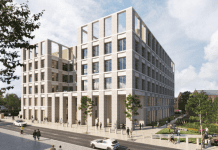Simone Protheroe, an associate on the construction team at national law firm Clarke Willmott, looks at how the changing face of the high street could be good news for increasingly popular mixed-use developments – and what this will mean for the communities surrounding them
The gradual decline of the high street has been taking place over a number of years, with retail battling the impact of the 2008 crash followed by the massive growth of online shopping and then a global pandemic. In addition, the concept of a “retail experience” has changed for consumers, causing a reducing impetus in the sector.
Consumer brands have increasingly directed their focus on building strong connections with customers via their own websites, social media platforms and other online-only marketplaces. This shift played a huge role in the dramatic fall of the high street and in particular its previously steadfast department stores, which have been a staple of the high street and shopping centres for generations – Debenhams was first founded in 1778.
The rapidly evolving face of the high street has seen the decline of many familiar brands including BHS, House of Fraser and Debenhams. In the last five years, the UK has seen an 83% loss in its department store space, with 388 stores being shut since 2016.
The impact of Covid-19 has also played a huge role in raising the number of high street stores that either closed permanently or shifted to e-commerce. The units in question are large and many are currently standing empty. Furthermore, many of the units are aging buildings meaning disrepair is likely. But could this be the answer to the growing demand for mixed-use development sites?
With some forward-thinking creativity in the current real estate and construction market, the redevelopment of the nation’s empty department stores could be a positive move.
Individual retail chains are unlikely to want such large spaces anymore and department stores are often situated in areas not particularly suited to becoming purely residential units. Add to this the catalyst effect the pandemic has had on the changing shape of the high street and you are left with a significant number of unlet units.
Enter mixed-use developments, the perfect solution to seeing these (often historic) buildings reoccupied and transformed from their current eyesore states.
A world of opportunity for innovative solutions
Over the years, mixed-use developments evolved from a traditional residential building with retail on the ground floor to a more complex, retail-led development with attached residential or leisure facilities.
Using department stores as mixed-use sites opens up a world of opportunity for innovative solutions. An example is the former BHS store on Edinburgh’s Princes Street, which is now part hotel, part office space, part leisure with a bowling alley in the basement.
The concept of the mixed-use development is become increasingly popular as a solution to adapt to our multifaceted requirements of modern spaces. These significant and extensive spaces have the potential to become important and functional sites, and through collaboration it is possible to regenerate our rapidly changing high streets.
Mixed-use developments have become a fundamental feature of any planning policy, due to the benefits they provide not only to high street departments in big cities but also to urban centres. By adopting mixed-use developments, the local community would benefit from local economic improvements, social connectivity and sustainability.
Nevertheless, while mixed-use developments would usually have diverse commercial tenants, developers may need to use a professional management service company to well address the needs of the whole community of tenants.
While seeking to multi-facilitate and multi-let these units may be a solution, it isn’t one without challenges. Due consideration should be given to the multiple ways for structuring the legal interests in a new mixed-use development, because once a legal structure is selected it can be very difficult to change. Developers, funders, leaseholders and contractors are going to have consider a plethora of issues before embarking on such projects including, but not limited, to:
- Listed building consents.
- Planning permissions.
- Insurance obligations.
- Party wall agreements.
- Design responsibility.
- The use of a joint venture.
- Appropriate forms of building contract and at the potential for more than one contractor.
- Conditions surveys and risk allocation.
- Agreements for lease for a multitude of leaseholders.
- Forward funding requirements.
Early examination and analysis of the diverse legal and regulatory prerequisites of mixed-use developments is the key to their success.

Simone Protheroe
Associate
Tel: +44 (0)203 733 6000
Twitter: ClarkeWillmott
LinkedIn: Clarke Willmott

















